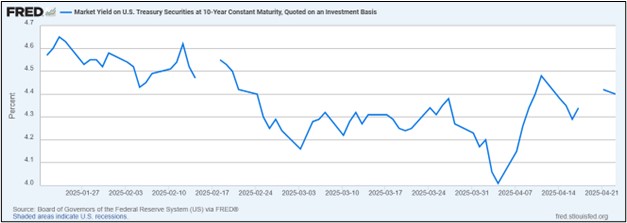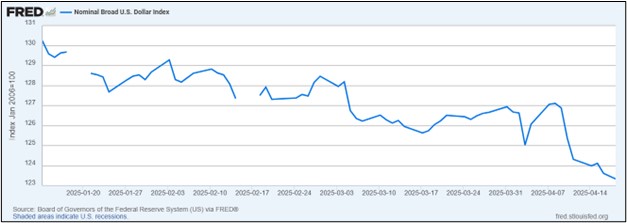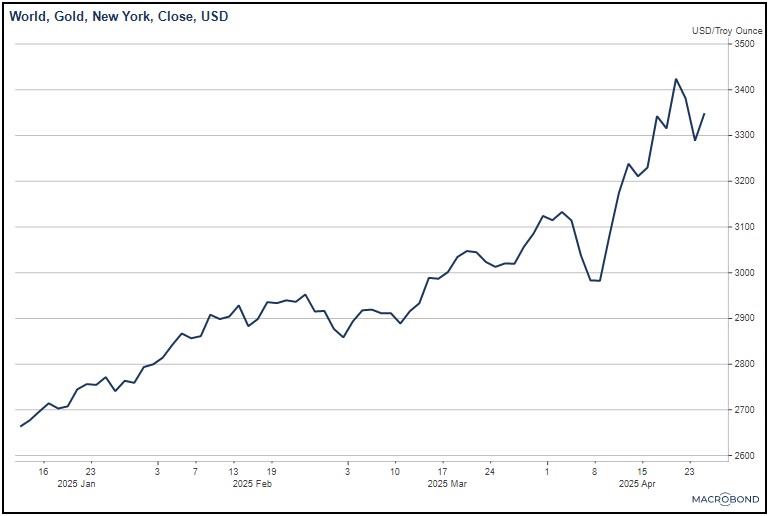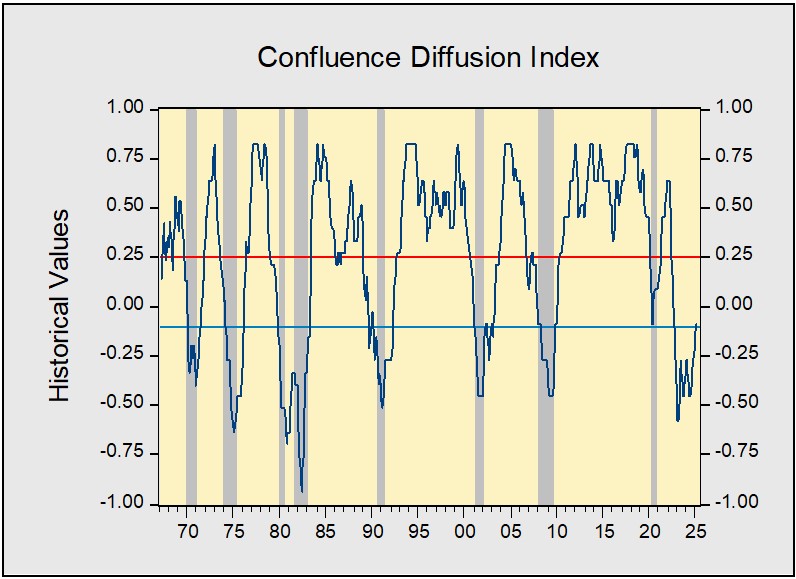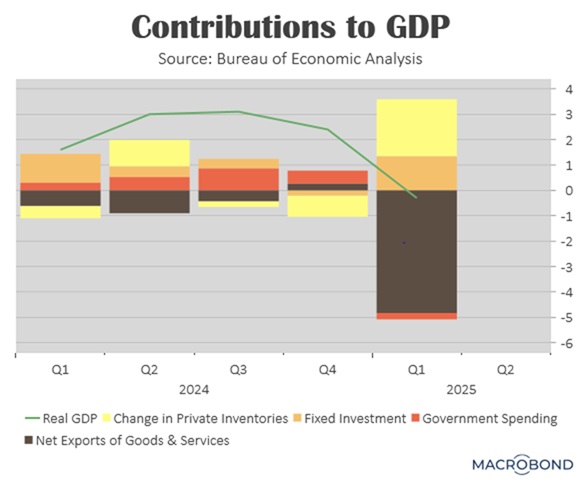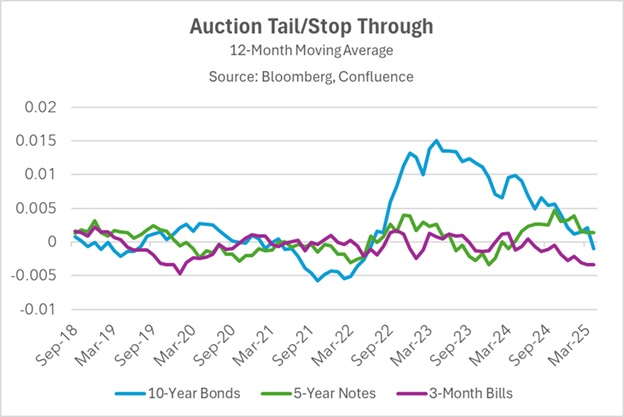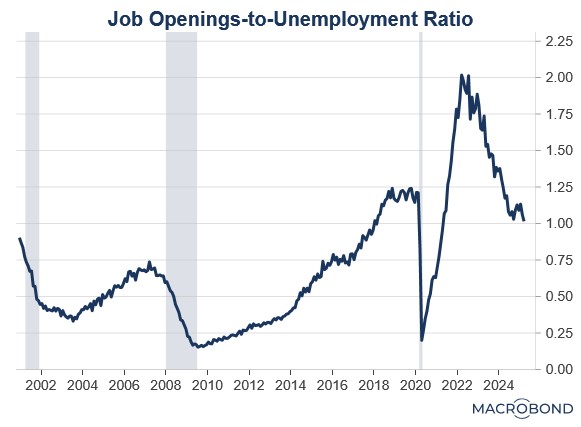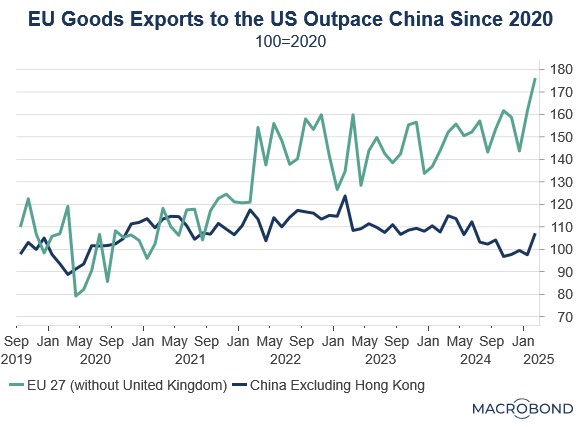Author: Amanda Ahne
Daily Comment (May 13, 2025)
by Patrick Fearon-Hernandez, CFA, and Thomas Wash
[Posted: 9:30 AM ET] | PDF
Our Comment today opens with an added US concession in the tariff war between Washington and Beijing, which will likely help de-escalate tensions between the two sides. We next review several other international and US developments that could affect the financial markets today, including an incendiary accusation by Poland that Russia was responsible for an arson fire last year that destroyed Warsaw’s biggest shopping mall (pun intended) and new signs that US lawmakers will gut many green-tech tax incentives, including for buying electric vehicles.
United States-China: After yesterday’s market euphoria over the news that the US and China had agreed to temporarily slash most of their tariffs on each other, the Trump administration last night clarified that it would also cut the US “de minimis” tariff on low-value parcels from China. Applied to packages with a retail value below $800, the de minimis tariff will now be cut to 54% from 120%. An optional $100 payment will be unchanged, rather than rising to $200. The move marks a further de-escalation in the US-China tariff war.
- The clarification will benefit Chinese retailers offering cheap goods directly to US consumers, such as Shein and Temu.
- Importantly, some low-end US retailers could also benefit, as they often rely on small shipments from China that qualify as de minimis parcels.
Russia-United States-Ukraine: President Trump yesterday told reporters that he might attend the planned Russia-Ukraine peace talks scheduled for Thursday in Turkey. The idea was quickly endorsed by Ukrainian President Zelensky, but we have seen no official response from Russian President Putin so far. Indeed, it’s still unclear whether Putin plans to attend. In any case, if Trump is serious about attending, it could set the stage for a potentially volatile, unpredictable meeting, which in itself could discourage Putin from participating.
Russia-Poland: Nearly a year after the largest shopping center in Warsaw burned to the ground, Polish Prime Minister Tusk said it is now confirmed that the fire was set by saboteurs working for the Russian intelligence services. The incident marks the latest instance of Russian destabilization efforts in the European Union. Those actions are likely to keep EU countries focused on rebuilding their militaries, which in turn will likely keep boosting EU defense firms and their stock prices.
Germany: Showing the extent to which populist nationalism and far-right authoritarianism have progressed in some Western democracies, the German government today banned the separatist organization “Kingdom of Germany” and confiscated its assets. Kingdom of Germany members have their own nominal king, reject Germany’s democratic institutions, and claim to rule a small enclave of about 2.4 acres near Wittenberg.
- Berlin’s move against Kingdom of Germany comes just days after it also declared the populist Alternative for Germany party to be a “rightwing extremist” organization, despite the party’s success in winning about one-fifth of the votes in the February federal elections. The designation gives the government the right to monitor the AfD more closely, including by tapping its communications.
- The designation has also sparked public debate over whether to ban the AfD outright. In a survey published over the weekend, some 53% of respondents favored such a ban.
United Kingdom: As firms dealt with an increase in national insurance contributions last month, April payroll employment fell by a seasonally adjusted 33,000, after a drop of 47,000 in March. The report also showed that average hourly earnings in the three months ended in March rose just 5.6% from the same period one year earlier, matching expectations but slowing from the annual rise of 5.9% in the three months ended in February. Weaker hiring but still-high wage growth is expected to keep the Bank of England cautious about cutting interest rates.
US Price Inflation: Late last week, economists at the Federal Reserve published a paper describing a new method to estimate the real-time impact of import tariffs on consumer price inflation. Looking at individual categories of personal consumption expenditures, the tariffs implemented for each category, the prevalence of imports in each category, and assumptions about pass-through from tariffs to consumer prices, the analysis estimates that President Trump’s tariffs this year have already boosted core consumer prices by 0.1%.
US Drug Industry: After hinting on Sunday that he would sign an order aggressively cutting US drug prices to “most favored nation” levels, the measure that President Trump signed yesterday only directed the Department of Health and Human Services to assist any drug company that wants to establish a direct-to-consumer purchasing program. The order threatened aggressive action against the drug firms if they don’t voluntarily cut their prices, but that was less stringent than feared. As a result, pharmaceutical stocks yesterday generally rose.
US Green Technology Industry: As we continue to process the draft budget bill presented by Republicans in the House, we note that one set of provisions would end a range of subsidies for green technology. For example, the proposal would end the $7,500 tax credit for buyers of new electric vehicles by the end of 2027 — despite the recent strong support for President Trump by Tesla chief executive Elon Musk. However, it’s important to remember that the bill at this point remains just a proposal, so it’s far too soon to know whether the provisions will become law.
Bi-Weekly Geopolitical Report – Update on the US-China Military Balance of Power (May 12, 2025)
by Daniel Ortwerth, CFA | PDF
In early 2021, we published a series of reports assessing the overall balance of power between the United States and China in military, economic, and diplomatic terms. In early 2023, we provided an update to our analysis. The current report is the next in what we intend to be a biennial series on the subject. Looking comprehensively at both countries’ power and sources of power, we assess that, while the US retains the greater military capacity to influence the world and protect its interests, China continues to close the gap, perhaps at an accelerating pace. For example, China continues to expand its lead in the number of combat-capable ships in its navy, it has gained valuable operational experience, and it can deploy enormous forces to the South China Sea, the East China Sea, and the Taiwan Strait. China’s coastal military forces are now strong enough to potentially deter the US from intervening in a crisis around Taiwan.
In this report, we provide an update to the numerical comparison and our analysis of China’s military development over the last two years. We emphasize critical areas such as China’s continuing buildup of its strategic nuclear arsenal and how that could spur a destabilizing new global arms race. We conclude with the implications for investors.
Don’t miss our accompanying podcasts, available on our website and most podcast platforms: Apple | Spotify
Asset Allocation Bi-Weekly – #139 “US Capital Flight and the Implications for Investors” (Posted 5/5/25)
Asset Allocation Bi-Weekly – US Capital Flight and the Implications for Investors (May 5, 2025)
by Patrick Fearon-Hernandez, CFA | PDF
Oh, what a difference one calendar quarter can make! Shortly after Donald Trump was sworn in to his second term as president of the United States, we wrote that the US seemed to enjoy exceptional advantages versus the rest of the world in terms of its economic growth, political stability, and stock market returns. Other economists and market commentators echoed those views. However, just three months into Trump’s new term, many investors seem to be losing confidence in the US’s economic growth and management. As we discuss in this report, the evidence pointing in that direction includes a rise in the yields on US Treasury obligations, a depreciating dollar, and surging gold prices. Below, we discuss these trends and what they may mean for world financial markets going forward.
Reduced Bond Buying / Rising Bond Yields. As shown in the chart on the next page, the yield on the benchmark 10-year Treasury note stood at 4.57% on the first business day after Trump’s inauguration in January. Investors continued to scoop up Treasurys in the weeks following the ceremony, driven by expectations of slower economic growth, easing inflation pressures, and further interest rate cuts by the Federal Reserve. As the administration revealed more about its tariff plans and other aspects of economic policy, growing concerns about the US economy pushed 10-year Treasury yields as low as 4.01% in early April. Since then, however, Treasurys have sold off sharply. Importantly, it appears that foreign institutions in Japan and elsewhere have been a big part of the sell-off. In any case, 10-year Treasury yields have spiked to more than 4.40% since mid-April. The yield on 30-year Treasurys has spiked to as high as 4.91%.
A Depreciating Dollar. Just as US Treasurys have sold off, the dollar has depreciated against many key currencies. The chart below shows the Fed’s nominal US Dollar Index, which tracks the value of the greenback against a broad range of foreign currencies. The broad index shows the dollar has lost about 4.10% of its value since Inauguration Day, with an especially sharp drop since Trump announced the pause in his “reciprocal” tariffs on April 9. The dollar has especially fallen sharply against developed country currencies, such as the euro.
Rising Gold Prices. Rising bond yields and a falling dollar point to falling confidence in the US among global investors, so it should be no surprise that gold — the quintessential safe haven — has appreciated sharply. As shown in the next chart, gold prices have even reached a record high above $3,400 per ounce, with much of the increase coming since early April.
Of course, many long-term investors have been more focused on the recent volatility in US risk assets, especially stocks. In our view, the unique combination of market forces described above may be the more important underlying story. The rise in US bond yields, the decline in the dollar, and the surge in gold represent a rare alignment of market trends that may indicate some measure of capital flight from the US. This pattern of market moves suggests that global and even some domestic investors are trying to cut their exposure to US assets and the dollar. The likely culprit is the administration’s effort to rapidly and fundamentally change the US economic relationship with the rest of the world. As long as that endeavor continues, and investors are unsure of where the to-and-fro of policymaking will take them, these trends are likely to remain in place. Therefore, over the coming months and quarters, the most attractive assets may be much different than what we and other observers had expected at the start of the year. In particular, any continued US capital flight is likely to favor foreign equities, foreign currencies, and gold in the near term.
Don’t miss our accompanying podcasts, available on our website and most podcast platforms: Apple | Spotify
Bi-Weekly Geopolitical Podcast – #65 “Export Controls: Another Battle in the US-China Trade War” (Posted 5/2/25)
Business Cycle Report (May 1, 2025)
by Thomas Wash | PDF
The business cycle has a major impact on financial markets; recessions usually accompany bear markets in equities. The intention of this report is to keep our readers apprised of the potential for recession, updated on a monthly basis. Although it isn’t the final word on our views about recession, it is part of our process in signaling the potential for a downturn.
The Confluence Diffusion Index for April, which encompasses data through March, remained slightly above the recovery indicator. However, the report showed that five out of 11 benchmarks are in contraction territory. Using March data, the diffusion index was unchanged at -0.0909 and above the recovery signal of -0.1000.
- Equity prices have seen a sharp decline in momentum.
- Construction activity shows marked deceleration.
- Labor market conditions are easing slightly but remain historically tight.
The chart above shows the Confluence Diffusion Index. It uses a three-month moving average of 11 leading indicators to track the state of the business cycle. The red line signals when the business cycle is headed toward a contraction, while the blue line signals when the business cycle is in recovery. The diffusion index currently provides about six months of lead time for a contraction and five months of lead time for recovery. Continue reading for an in-depth understanding of how the indicators are performing. At the end of the report, the Glossary of Charts describes each chart and its measures. In addition, a chart title listed in red indicates that the index is signaling recession.
Daily Comment (May 1, 2025)
by Patrick Fearon-Hernandez, CFA, and Thomas Wash
[Posted: 9:30 AM ET] | PDF
Good morning! The market is currently digesting the latest tech earnings. On the ice, the Jets secured a third playoff victory against the Blues. Today’s Comment dives into why we’re not overly concerned about the economic contraction in Q1, the market’s focus on Treasury developments, and other key market news. As always, we’ll also provide a summary of relevant international and domestic data releases.
GDP Contracts: While the economy’s contraction in Q1 has intensified recession concerns, a closer examination of the underlying data paints a more nuanced picture.
- The US economy shrank at an annualized rate of 0.3% in Q1 2025, marking the first quarterly decline since 2022. This downturn was primarily driven by a surge in imports as businesses and consumers accelerated foreign purchases ahead of anticipated tariff implementations. The flood of foreign goods more than offset gains in domestic consumption and fixed investment. Further exacerbating the weakness, a drop in government spending created additional headwinds for economic growth.
- While the import surge is expected to reverse — easing GDP concerns — the sustainability of recent consumption and investment growth remains doubtful. Much of the apparent strength stems from temporary factors such as businesses stockpiling inventory ahead of tariffs and using existing stock to suppress price hikes, therefore artificially boosting demand. These short-term dynamics suggest that underlying economic weakness may persist once these one-off boosts fade.
- The report also revealed emerging signs of inflationary pressures as the GDP price deflator — the inflation measure used to adjust nominal output for price changes — accelerated to its fastest pace since Q4 2022. This sharp increase, driven primarily by stronger adjustments to prices related to personal consumption and government spending, may fuel concerns about potential stagflation risks in the economy.
- We advise investors against overreacting to this single economic report as conditions are expected to shift throughout the year. As we’ve highlighted previously, the administration likely anticipated an early-year slowdown, positioning itself to deploy stimulative policies like tax cuts later this year to reinvigorate growth. Such measures could materialize in the coming months, potentially boosting the economy ahead of next year’s midterm elections.
Under the Radar: The Treasury signaled no changes to its borrowing program, sticking with existing issuance levels even as investors worry about bond market saturation.
- The US Treasury’s latest quarterly refunding announcement maintained steady issuance sizes for long-term bonds, with officials indicating this approach would continue for “several quarters.” While market participants had speculated about potential bond buyback changes to address supply concerns, Treasury Secretary Bessent only confirmed that the department is studying such measures but stopped short of committing to implementation or providing a timeline.
- Growing speculation about an expanded buyback program follows weeks of exceptional volatility in long-dated bonds. The 10-year Treasury’s trading range in April marked its widest swing since the March 2023 banking crisis triggered by Silicon Valley Bank’s collapse. While these adjustments would extend a program initiated by the prior administration, market participants view the potential expansion as further evidence of the Treasury’s increasingly active role in the bond market.
- The statutory debt limit has further complicated the Treasury’s position, preventing increases in net Treasury supply and forcing reliance on cash reserves and extraordinary measures to maintain government funding. The department is expected to announce in early May when these temporary measures will be exhausted, potentially adding another layer of uncertainty for the Treasury market.
- Though boring, Treasury auctions are emerging as a critical market force. Successive administrations have deliberately managed issuance patterns to prevent liquidity shortfalls and improve market functioning. We expect coordinated Treasury and Federal Reserve action to actively contain long-term yield volatility in the future, creating potential tailwinds for both fixed income and equity markets as policymakers intervene to maintain orderly conditions.
BOJ Holds Off Hikes: The Bank of Japan is postponing its policy normalization plans as it continues to assess the potential economic impact of US tariffs.
- The Bank of Japan held its policy rate steady at 0.5%, while slashing its 2025 GDP growth forecast by more than half — from 1.1% to 0.5% — citing heightened risks from US tariffs imposed on Japan’s export-driven economy. Despite inflation being above its 2% inflation target, policymakers opted to delay rate hikes, signaling concern over near-term headwinds while preserving flexibility for possible monetary tightening should economic conditions stabilize.
- Japan’s economy has taken center stage in global markets as investors gauge how potential shifts in trade policy could reverberate across the world economy. The Trump administration has placed Japan at the forefront of its trade agenda, heightening the significance of ongoing bilateral negotiations. However, progress of the talks remains uncertain, with Japanese Prime Minister Shigeru Ishiba recently asserting that Japan will not compromise its national interests to accommodate US demands.
- The two nations are preparing for a third round of trade talks in which Japan is anticipated to offer an increase in imports of US rice and soybeans, while easing certain auto safety regulations. However, more substantial concessions appear unlikely as Ishiba faces domestic political constraints ahead of July’s critical elections, limiting flexibility for potentially unpopular trade compromises.
- Given the risk of slowing growth ahead of elections, the BOJ will likely delay monetary tightening to avoid additional economic strain. This dovish stance should support global bond markets as higher Japanese rates could have prompted the nation’s institutional investors, a crucial source of global fixed income demand, to repatriate significant capital.
US Tech Shows Life: Despite growing concerns about the economic fallout from the tariffs, robust tech earnings — particularly in AI-focused companies — demonstrate the sector’s remarkable resilience.
- Several mega-cap tech leaders revealed robust earnings growth in their cloud computing divisions, with Microsoft and Meta both surpassing market expectations, fueling positive momentum across the AI sector. Investor attention now turns to upcoming reports from Apple and Amazon, particularly focusing on how these companies navigated supply chain challenges amid escalating trade tensions last quarter.
- AI-related sectors are likely to be among the first to rebound as global economic expectations reset, with investors favoring established players that have demonstrated consistent growth. However, the sector may experience heightened volatility if ongoing macroeconomic uncertainty persists in the coming months.
Daily Comment (April 30, 2025)
by Patrick Fearon-Hernandez, CFA, and Thomas Wash
[Posted: 9:30 AM ET] | PDF
Good morning! Markets are digesting the latest GDP figures. In sports news, the Indiana Pacers secured a victory over the Milwaukee Bucks in last night’s NBA playoff action. Today’s Comment will focus on growing concerns about a potential US recession, the EU’s weighing of China trade talks, and other important market developments. As always, we’ve included our regular summary of both domestic and international economic data releases to keep you informed.
Recession Worries Rise: Despite rising fears of an economic slowdown, equities and bonds have not dropped as investors remain optimistic about possible intervention by the Fed.
- April’s Consumer Confidence Index plummeted to 86.0 — a five-year low — which is down sharply from March’s 93.9 reading. The decline reflects growing public anxiety that tariffs are dampening economic prospects. While the Present Situation Index remained relatively stable at 133.5 (down just 0.9 points), the Expectations Index cratered to 54.4, its weakest level since October 2011 and far below the 80-point threshold typically associated with recession.
- Pessimism is increasingly evident in real-time economic data as well. The latest JOLTS report revealed a decline in job openings, dropping from 7.48 million to 7.19 million in March. The ratio of job openings to unemployed workers also fell to its lowest level in four years. Meanwhile, the housing market continues to lose momentum, with national home prices rising just 0.1% month-over-month in February, well below the 0.3% consensus estimate.
- Despite the disappointing data, market optimism persists that Federal Reserve action could provide a boost. The recent weak economic indicators have prompted investors to price in additional rate cuts, with the CME FedWatch Tool now indicating a high probability of the central bank implementing its first rate cut for the year by June. Additionally, the Fed is now expected to cut rates by 100 bps by the end of the year.
- Markets are pricing in a June rate cut, but pressure is mounting on the Fed to act sooner. President Trump has intensified his calls for immediate easing at the May 7 meeting to stave off a potential downturn. He has repeatedly criticized Chair Powell’s cautious approach to shifting economic conditions and is now reportedly considering appointing a shadow Fed chair, a move that could undermine Powell’s authority and sway over markets.
- Next Wednesday, the Fed will likely have to weather a storm of concerns about the strength of the economy as well as the potential inflationary impact on tariffs. Most Fed officials have signaled that they will likely keep rates unchanged until they have a better understanding of where the economy is heading. As a result, we suspect the upcoming labor report on Friday will play a strong role as to whether the Fed will cut rates next week.
EU Playing Both Sides? The bloc of European countries is currently weighing trade talks with China while simultaneously pushing for a deal with the US.
- The Chinese government has lifted sanctions on five European parliament members who had criticized China’s human rights record, marking a goodwill gesture ahead of bilateral trade talks. While European officials welcomed this move, negotiations are expected to include discussions about China’s industrial policies as well as accusations of dumping. The thaw in relations may accelerate following the Ukraine war’s conclusion, as both sides had supported opposing factions in the conflict.
- The diplomatic thaw unfolds as Europe wrestles with its fraught relationship with Washington amid escalating US tariffs on EU exports. Despite lingering hesitancy, there are growing signs that Europe may be open to dialogue with Beijing. Spanish PM Pedro Sánchez has pushed for stronger EU-China engagement, while Italy’s Giorgia Meloni maintains pragmatic bilateral ties despite withdrawing from China’s Belt and Road Initiative.
- Meanwhile, US-EU trade negotiations remain deadlocked, with the bloc’s Digital Services Tax continuing to serve as a major obstacle. The impasse was most recently highlighted by Treasury Secretary Bessent, who identified the controversial tax as a key sticking point before the two sides can come to an agreement.
- While the EU’s engagement with China is unlikely to fundamentally shift its strategic alignment with the US, it underscores a shifting geopolitical terrain where nations adapt to a less accommodating America retreating from its role as the primary absorber of global demand. We foresee the EU navigating a delicate balance between Washington and Beijing to further its global economic objectives.
- In the near to medium term, the euro could find tailwinds from two primary sources: (1) the US administration’s apparent inclination towards dollar depreciation to stimulate exports, and (2) the potential for increased Chinese capital inflows into European markets.
India-Pakistan Feud Escalates: The two neighboring countries appear to be heading toward direct conflict, as both sides continue escalating tensions with provocative actions that risk triggering war.
- Tensions between the two nations continue to build following a deadly Islamist militant attack in India-administered Kashmir last week that killed 26 people. In response, Indian Prime Minister Narendra Modi has vowed retaliation, accusing Pakistan of involvement in the assault. Since the attack, both sides have shot down each other’s surveillance drones near their shared border. On Tuesday, Pakistan’s defense minister warned that war could erupt within 2-3 days if tensions continue to rise.
- The US faces a significant challenge as it attempts to maintain both countries within its sphere of influence. While India maintains ties with China, it also stands to benefit substantially as the US seeks to reduce its reliance on the world’s second-largest economy. Pakistan, on the other hand, remains a strategic partner — a status underscored by the Trump administration’s decision to exempt the country from the budget cuts it made in foreign aid.
- In this tense situation, US Secretary of State Rubio is getting ready for important talks with both countries. He needs to do two things: 1) stop the fighting from getting worse, and 2) protect America’s interests in the region. If these talks fail, it could be very dangerous. India and Pakistan both have nuclear weapons, and if they go to war, it could scare investors and hurt economies around the world.
Ukraine Deal Close? Ukrainian officials may sign a minerals deal today, as Trump holds out hope that Putin will end his invasion of the country.
- Ukrainian Economy Minister Yulia Svyrydenko will visit Washington this week to conclude a landmark bilateral agreement following extended negotiations. The pact establishes a framework for repaying future US military assistance while locking in foreign investment for Ukraine’s postwar rebuilding. The timing is significant, as it comes amid President Trump’s vocal criticisms of the negotiation delays.
- Although the US-Ukraine deal is nearing completion, concerns persist that Russia may reject the proposed peace terms. President Vladimir Putin continues to insist on annexing four partially occupied regions as a precondition for any settlement. Despite these demands, President Trump remains optimistic about persuading Putin to scale back his territorial claims to end the conflict.
- Although the timeline for the ending of hostilities remains uncertain, we anticipate the conflict’s conclusion within the coming months. The resolution of the war should provide support for global risk assets and could exert downward pressure on international energy prices.



